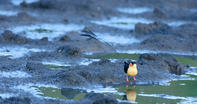
Name
Whydah or paradise whydah The whydah birds genus is Vidua, which is the Latin for widow, due to the breeding male’s black plumage and long tail, which looks like a black veil.Whydahs Appearance
All Whydahs have eclipse plumage or non-breeding plumage. The males are drab looking, the same as their respective females, for most of the year. During the breeding season, the eclipse plumage is transformed into brightly coloured breeding plumage, also known as nuptial plumage.
This involves changes to the physical characteristics and dimensions of the tail feathers and overall plumage. The tail feathers can grow to become one and a half times the length of the bird. The females are a drab, sparrow look-alike bird, throughout the year.
Whydahs Diet
Whydahs are seed eaters, but they do occasionally take insects.Whydahs Breeding
During the breeding season, when the males are in their nuptial plumage, the whydah males use displays to in an attempt to attract females. When whydahs are found in high densities, then the males use a lek to perform their displays.
A lek is a mating system, in which a number of male birds all display in a competition for females, at the same time and place. All whydahs and paradise-whydahs are brood parasite’s, with the hosts being estrildid waxbills and pytillia.
The adult whydahs mimic the host calls and the chicks mimic the host's mouth patterns and begging behaviour. Unlike most other brood parasites, the whydahs do not remove and replace the host's egg, she just adds her egg to the nest. The whydah chicks do not kill the host’s other chicks, but does compete for food with it’s “siblings”. Whydahs only lay 1 egg per hosts nest.
 Breeding males have a very long tail that is up to 3 times his body length and a change in plumage. Breeding males have glossy black plumage...
Breeding males have a very long tail that is up to 3 times his body length and a change in plumage. Breeding males have glossy black plumage... The pin-tailed whydah is around 13 cm in length. The male in breeding plumage has a long tail, of up to 20 cm in length, with the bird havin...
The pin-tailed whydah is around 13 cm in length. The male in breeding plumage has a long tail, of up to 20 cm in length, with the bird havin... The shaft-tailed whydah is a small bird, around 13 cm in length. The male shaft-tailed whydah in breeding plumage has a long tail, up to 16 ...
The shaft-tailed whydah is a small bird, around 13 cm in length. The male shaft-tailed whydah in breeding plumage has a long tail, up to 16 ...